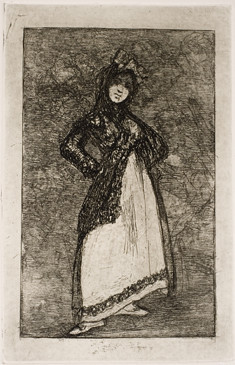- Cronología
- 1826 - 1828
- Dimensiones
- 191 x 122 mm
- Técnica y soporte
- Aguatinta, aguafuerte y bruñidor
- Reconocimiento de la autoría de Goya
- Documented work
- Ficha: realización/revisión
- 22 Feb 2011 / 15 Jun 2023
- Inventario
- 225
This group of four engravings made in Bordeaux, the last ones Goya executed, constitute a mini-series called "Last Caprices" or "New Caprices" (a term coined by Eleanor Sayre), although they have nothing to do with the series of 1799. They have been considered part of an unfinished series, or else single works complementary to the drawing albums produced in Bordeaux (and in particular Album H). Perhaps these prints are the "best ideas" to which Goya alludes in a letter to his friend Joaquín María Ferrer, exiled in Paris, dated 1825, in response to the latter's suggestion to reprint the Caprices.
A good technical mastery can be appreciated, as well as the mixture of delicacy and vigour, despite the artist's advanced age. Some authors have pointed out the possible influence of the simultaneous practice of lithography, as the traces of the strokes and profiles are softer than in his earlier etchings.
Similar compositions are engraved on the backs of the plates, open only to etching and which seem to be copies of three drawings from Album H (nos. 22, 31 and 58) which served as a reference for the compositions on the front. Two of these reverses, Lady on a light background. (reverse of Lady on a dark background.) and The Embossed Man (idem of Andalusian Smuggler ), are unanimously considered to have been executed by another hand, and there are doubts about the third, Old Woman Swinging (idem of Old Man Swinging).
Only period proofs of Old Man Swinging and The Blind Singer survive, while only posthumous prints exist of Lady on a Dark Background and Andalusian Smuggler. Except for the plate of The Blind Singer, which belonged to Paul Lefort, the others were acquired in 1859 from Mariano Goya by the English diplomat John Savile Lumley, who asked the Calcografía Nacional to print the front and back of his three plates, except for Andalusian Smuggler, due to the poor condition of the plate.
In 1926 the three plates were acquired by the firm of Colnaghi (London), who made an edition at the School of the Museum of Fine Arts, Boston, using different types of antique and modern paper. In 1938 the plates passed to Philip Hofer (Cambridge, Massachusetts), for whom Ture Bengtz made a print in 1954 and Russell T. Limbach another in 1960. Hofer finally donated the plates in 1970 to the Museum of Fine Arts, Boston, where they are now kept. In 1971 Eleanor Sayre published a catalogue raisonné and twenty-five copies of that edition included a numbered edition of six prints (obverse and reverse) by Emiliano Sorini (New York).
In the engraving we see a woman of the maja type, with a mantilla and arms raised, in a provocative attitude, surrounded by heads (demons on the prowl?) looming in the dark background. Possible portrait of Leocadia Zorrilla de Weiss, Goya's partner at the time.
Goya started with an etching, shading with aquatint and then saving the white parts (face, skirt and shoes) with the burnisher.
There is a preparatory drawing, Maja, included in Album H and now in the Prado Museum.
-
Exposición de la obra grabada de GoyaSociedad Española de Amigos del ArteMadrid1928catalogue by Miguel Velasco Aguirrecat.38
-
Grabados y dibujos de Goya en la Biblioteca NacionalBiblioteca NacionalMadrid1946catalogue Elena Páez Ríoscat. 125
-
De grafiek van GoyaRijksmuseum RijksprentenkabinetAmsterdam1970from November 13th 1970 to January 17th 1971p.47-48, cat.147
-
El arte de GoyaMuseo de Arte Occidental de TokioTokyo1971from 16th 1971 to January 23th 1972. Exhibited also at the Kyoto Municipal Museum of Art, January 29th to March 15th 1972.cat. 152
-
Goya en la Biblioteca Nacional. Exposición de grabados y dibujos en el sesquicentenario de su muerteBiblioteca NacionalMadrid1978May - June 1978cat. 138
-
Goya. Das Zeitalter der Revolucionen. Kunst um 1800 (1980 – 1981)Hamburger KunsthalleHamburg1980cat. 277
-
Goya grabadorFundación Juan MarchMadrid1994consultant editors Alfonso E. Pérez Sánchez and Julián Gállego, from January 14th to March 20th 1994cat. 1
-
Ydioma universal: Goya en la Biblioteca NacionalBiblioteca NacionalMadrid1996from September 19th to December 15th 1996cat. 328
-
Goya y Moratín [En Burdeos, 1824 – 1828]Museo de Bellas Artes de BilbaoBilbao1998consultant editor Françoise Garcíacat. 27
-
Goya engravings and lithographs, vol. I y II.OxfordBruno Cassirer1964vol. II, 1983, cat. 30-35, pp.51-59
-
Vie et ouvre de Francisco de GoyaParísOffice du livre1970pp.345-349, cat.1823-1829
-
Late Caprichos of Goya, Fragments from a SerieNew YorkPhilip Hofer Books1971
-
The Changing image: Prints by Francisco GoyaBostonMuseum of Fine Arts1974
-
Dibujos de Goya, 2 volsBarcelonaNoguer1975pp. 573-648
-
Goya, Das Zeitalter de Revolutionen. 1789-1830HamburgPrestel-Verlag Münche und Hamburger Kunsthalle1980pp. 307-308
-
Catálogo de las estampas de Goya en la Biblioteca NacionalMadridMinisterio de Educación y Cultura, Biblioteca Nacional1996pp.53-54, cat.72-76A
-
Goya's prints: the Tomás Harris collection in the British MuseumLondonBritish Museum Publications1996
-
Ydioma universal: Goya en la Biblioteca NacionalMadridBiblioteca Nacional, Sociedad Estatal Goya 96 y Lunwerg1996pp.290-293
-
Goya. Estampas. Grabado y litografíaBarcelonaElecta ediciones2007pp. 44-45, 347 y 374, núm. 283
